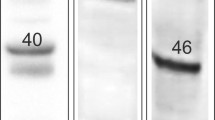Abstract
G-protein-coupled receptors (GPCRs) constitute the largest family of transmembrane receptors and regulate a variety of physiological and disease processes. Although the roles of many non-odorant GPCRs have been identified in vivo, several GPCRs remain orphans (oGPCRs). The gastrointestinal (GI) tract is the largest endocrine organ and is a promising target for drug discovery. Given their close link to physiological function, the anatomical and histological expression profiles of benchmark GI-related GPCRs, such as the cholecystokinin-1 receptor and GPR120, and 106 oGPCRs were investigated in the mucosal and muscle-myenteric nerve layers in the GI tract of C57BL/6J mice by quantitative real-time polymerase chain reaction. The mRNA expression patterns of these benchmark molecules were consistent with previous in situ hybridization and immunohistochemical studies, validating the experimental protocols in this study. Of 96 oGPCRs with significant mRNA expression in the GI tract, several oGPCRs showed unique expression patterns. GPR85, GPR37, GPR37L1, brain-specific angiogenesis inhibitor (BAI) 1, BAI2, BAI3, and GPRC5B mRNAs were preferentially expressed in the muscle-myenteric nerve layer, similar to GPCRs that are expressed in both the central and enteric nerve systems and that play multiple regulatory roles throughout the gut-brain axis. In contrast, GPR112, trace amine-associated receptor (TAAR) 1, TAAR2, and GPRC5A mRNAs were preferentially expressed in the mucosal layer, suggesting their potential roles in the regulation of secretion, immunity, and epithelial homeostasis. These anatomical and histological mRNA expression profiles of oGPCRs provide useful clues about the physiological roles of oGPCRs in the GI tract.





Similar content being viewed by others
References
Bjarnadottir TK, Gloriam DE, Hellstrand SH, Kristiansson H, Fredriksson R, Schioth HB (2006) Comprehensive repertoire and phylogenetic analysis of the G protein-coupled receptors in human and mouse. Genomics 88:263–273
Bjarnadottir TK, Fredriksson R, Schioth HB (2007) The adhesion GPCRs: a unique family of G protein-coupled receptors with important roles in both central and peripheral tissues. Cell Mol Life Sci 64:2104–2119
Bockaert J, Pin JP (1999) Molecular tinkering of G protein-coupled receptors: an evolutionary success. EMBO J 18:1723–1729
Burdyga G, Lartigue G de, Raybould HE, Morris R, Dimaline R, Varro A, Thompson DG, Dockray GJ (2008) Cholecystokinin regulates expression of Y2 receptors in vagal afferent neurons serving the stomach. J Neurosci 28:11583–11592
Cheng YJ, Lotan R (1998) Molecular cloning and characterization of a novel retinoic acid-inducible gene that encodes a putative G protein-coupled receptor. J Biol Chem 273:35008–35015
Cox HM (2007) Neuropeptide Y receptors; antisecretory control of intestinal epithelial function. Auton Neurosci 133:76–85
Cummings DE, Overduin J (2007) Gastrointestinal regulation of food intake. J Clin Invest 117:13–23
Drucker DJ (2007) The role of gut hormones in glucose homeostasis. J Clin Invest 117:24–32
Engelstoft MS, Egerod KL, Holst B, Schwartz TW (2008) A gut feeling for obesity: 7TM sensors on enteroendocrine cells. Cell Metab 8:447–449
Fredriksson R, Schioth HB (2005) The repertoire of G-protein-coupled receptors in fully sequenced genomes. Mol Pharmacol 67:1414–1425
Fredriksson R, Lagerstrom MC, Lundin LG, Schioth HB (2003) The G-protein-coupled receptors in the human genome form five main families. Phylogenetic analysis, paralogon groups, and fingerprints. Mol Pharmacol 63:1256–1272
Gabella G (1985) Structure of the musculature of the chicken small-intestine. Anat Embryol (Berl) 171:139–149
Giorgio RD, Barbara G, Furness JB, Tonini M (2007) Novel therapeutic targets for enteric nervous system disorders. Trends Pharmacol Sci 28:473–481
Gross KJ, Pothoulakis C (2007) Role of neuropeptides in inflammatory bowel disease. Inflamm Bowel Dis 13:918–932
Hansen MB, Witte AB (2008) The role of serotonin in intestinal luminal sensing and secretion. Acta Physiol 193:311–323
Higashi H, Kohyama A, Hirabayashi Y (2007) Development of the drugs for metabolic diseases such as diabetes using RAIG2 and RAIG3 G-protein-coupled sugar receptors as targets. Riken, Tokio
Hirasawa A, Tsumaya K, Awaji T, Katsuma S, Adachi T, Yamada M, Sugimoto Y, Miyazaki S, Tsujimoto G (2005) Free fatty acids regulate gut incretin glucagon-like peptide-1 secretion through GPR120. Nat Med 11:90–94
Kidd M, Modlin IM, Gustafsson BI, Drozdov I, Hauso O, Pfragner R (2008) Luminal regulation of normal and neoplastic human EC cell serotonin release is mediated by bile salts, amines, tastants, and olfactants.Am J Physiol Gastrointest Liver Physiol 295:G260–G272
Kim YB, Peroni OD, Aschenbach WG, Minokoshi Y, Kotani K, Zisman A, Kahn CR, Goodyear LJ, Kahn BB (2005) Muscle-specific deletion of the Glut4 glucose transporter alters multiple regulatory steps in glycogen metabolism. Mol Cell Biol 25:9713–9723
Koda S, Date Y, Murakami N, Shimbara T, Hanada T, Toshinai K, Niijima A, Furuya M, Inomata N, Osuye K, Nakazato M (2005) The role of the vagal nerve in peripheral PYY3–36-induced feeding reduction in rats. Endocrinology 146:2369–2375
Koh JT, Lee ZH, Ahn KY, Kim JK, Bae CS, Kim HH, Kee HJ, Kim KK (2001) Characterization of mouse brain-specific angiogenesis inhibitor 1 (BAI1) and phytanoyl-CoA alpha-hydroxylase-associated protein 1, a novel BAI1-binding protein. Mol Brain Res 87:223–237
Koh JT, Kook H, Kee HJ, Seo YW, Jeong BC, Lee JH, Kim MY, Yoon KC, Jung S, Kim KK (2004) Extracellular fragment of brain-specific angiogenesis inhibitor 1 suppresses endothelial cell proliferation by blocking alpha(v)beta(5) integrin. Exp Cell Res 294:172–184
Lagerstrom MC, Schioth HB (2008) Structural diversity of G protein-coupled receptors and significance for drug discovery. Nat Rev Drug Discov 7:339–357
Lattin J, Zidar DA, Schroder K, Kellie S, Hume DA, Sweet MJ (2007) G-protein-coupled receptor expression, function, and signaling in macrophages. J Leukoc Biol 82:16–32
Leja J, Essaghir A, Essand M, Wester K, Oberg K, Totterman TH, Lloyd R, Vasmatzis G, Demoulin JB, Giandomenico V (2009) Novel markers for enterochromaffin cells and gastrointestinal neuroendocrine carcinomas. Eur J Clin Invest 39:17
Livak KJ, Schmittgen TD (2001) Analysis of relative gene expression data using real-time quantitative PCR and the 2(-Delta Delta C(T)) method.Methods 25:402–408
Lomax AE, Furness JB (2000) Neurochemical classification of enteric neurons in the guinea-pig distal colon. Cell Tissue Res 302:59–72
Lundstrom K (2006) Latest development in drug discovery on G protein-coupled receptors. Curr Protein Pept Sci 7:465–470
Lysikov YA, Morozov IA (1990) Ultrastructure of the juxtamural mucosal layer of the small-intestine. Bull Exp Biol Med 110:1583–1587
Marazziti D, Mandillo S, Di Pietro C, Golini E, Matteoni R, Tocchini-Valentini GP (2007) GPR37 associates with the dopamine transporter to modulate dopamine uptake and behavioral responses to dopaminergic drugs. Proc Natl Acad Sci USA 104:9846–9851
Matsumoto M, Straub RE, Marenco S, Nicodemus KK, Matsumoto SI, Fujikawa A, Miyoshi S, Shobo M, Takahashi S, Yarimizu J, Yuri M, Hiramoto M, Morita S, Yokota H, Sasayama T, Terai K, Yoshino M, Miyake A, Callicott JH, Egan MF, Meyer-Lindenberg A, Kempf L, Honea R, Vakkalanka RK, Takasaki J, Kamohara M, Soga T, Hiyama H, Ishii H, Matsuo A, Nishimura S, Matsuoka N, Kobori M, Matsushime H, Katoh M, Furuichi K, Weinberger DR (2008) The evolutionarily conserved G protein-coupled receptor SREB2/GPR85 influences brain size, behavior, and vulnerability to schizophrenia. Proc Natl Acad Sci USA 105:6133–6138
Miyamoto Y, Miyamoto M (2004) Immunohistochemical localizations of secretin, cholecystokinin, and somatostatin in the rat small intestine after acute cisplatin treatment. Exp Mol Pathol 77:238–245
Moore-Morris T, Varrault A, Mangoni ME, Le Digarcher A, Negre V, Dantec C, Journot L, Nargeot J, Couette B (2009) Identification of potential pharmacological targets by analysis of the comprehensive G protein-coupled receptor repertoire in the four cardiac chambers. Mol Pharmacol 75:1108–1116
Osei-Hyiaman D, Liu J, Zhou L, Godlewski G, Harvey-White J, Jeong WI, Batkai S, Marsicano G, Lutz B, Buettner C, Kunos G (2008) Hepatic CB1 receptor is required for development of diet-induced steatosis, dyslipidemia, and insulin and leptin resistance in mice. J Clin Invest 118:3160–3169
Patterson LM, Zheng HY, Berthoud HR (2002) Vagal afferents innervating the gastrointestinal tract and CCKA-receptor immunoreactivity. Anat Rec 266:10–20
Pierce KL, Lefkowitz RJ (2001) Classical and new roles of beta-arrestins in the regulation of G-protein-coupled receptors. Nat Rev Neurosci 2:727–733
Qu Z-D, Thacker M, Castelucci P, Bagyanszki M, Epstein ML, Furness JB (2008) Immunohistochemical analysis of neuron types in the mouse small intestine. Cell Tissue Res 334:147–161
Rayasam GV, Tulasi VK, Davis JA, Bansal VS (2007) Fatty acid receptors as new therapeutic targets for diabetes. Expert Opin Ther Targets 11:661–671
Regard JB, Sato IT, Coughlin SR (2008) Anatomical profiling of G protein-coupled receptor expression. Cell 135:561–571
Rettenbacher M, Reubi JC (2001) Localization and characterization of neuropeptide receptors in human colon. Naunyn Schmiedebergs Arch Pharmacol 364:291–304
Robbins MJ, Charles KJ, Harrison DC, Pangalos MN (2002) Localisation of the GPRC5B receptor in the rat brain and spinal cord. Mol Brain Res 106:136–144
Rozengurt N, Wu SV, Chen MC, Huang C, Sternini C, Rozengurt E (2006) Colocalization of the alpha-subunit of gustducin with PYY and GLP-1 in L cells of human colon. Am J Physiol Gastrointest Liver Physiol 291:G792–G802
Sanger GJ, Lee K (2008) Hormones of the gut-brain axis as targets for the treatment of upper gastrointestinal disorders. Nat Rev Drug Discov 7:241–254
Spiller R (2008) Serotonin and GI clinical disorders. Neuropharmacology 55:1072–1080
Wolinsky TD, Swanson CJ, Smith KE, Zhong H, Borowsky B, Seeman P, Branchek T, Gerald CP (2007) The trace amine 1 receptor knockout mouse: an animal model with relevance to schizophrenia. Genes Brain Behav 6:628–639
Yona S, Lin HH, Siu WO, Gordon S, Stacey M (2008) Adhesion-GPCRs: emerging roles for novel receptors. Trends Biochem Sci 33:491–500
Zhou J, Hegsted M, McCutcheon KL, Keenan MJ, Xi XC, Raggio AM, Martin RJ (2006) Peptide YY and proglucagon mRNA expression patterns and regulation in the gut. Obesity 14:683–689
Zucchi R, Chiellini G, Scanlan TS, Grandy DK (2006) Trace amine-associated receptors and their ligands. Br J Pharmacol 149:967–978
Author information
Authors and Affiliations
Corresponding author
Electronic supplementary material
Below is the link to the electronic supplementary material.
Supplementary Fig. 1
Expression profiles of oGPCRs preferentially expressed in the muscle-myenteric nerve layer of the studied GI regions (DM duodenum, UIS upper intestine, LIS lower intestine, PC proximal colon, vertical axis relative expression levels \( \left( {{2^{ - \Delta \Delta {\text{Ct}}}}} \right) \) of the respective genes, filled columns expression in the mucosal nerve layers, open columns expression in the muscle-myenteric nerve layers) (PDF 20 kb)
Supplementary Fig. 2
Expression profiles of oGPCRs preferentially expressed in the mucosal layer of the studied GI regions (DM duodenum, UIS upper intestine, LIS lower intestine, PC proximal colon, vertical axis relative expression levels \( \left( {{2^{ - \Delta \Delta {\text{Ct}}}}} \right) \) of the respective genes, filled columns expression in the mucosal nerve layers, open columns expression in the muscle-myenteric nerve layers) (PDF 17.5 kb)
Rights and permissions
About this article
Cite this article
Ito, J., Ito, M., Nambu, H. et al. Anatomical and histological profiling of orphan G-protein-coupled receptor expression in gastrointestinal tract of C57BL/6J mice. Cell Tissue Res 338, 257–269 (2009). https://doi.org/10.1007/s00441-009-0859-x
Received:
Accepted:
Published:
Issue Date:
DOI: https://doi.org/10.1007/s00441-009-0859-x




